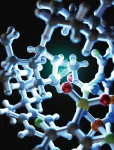(Press-News.org) RIVERSIDE, Calif. -- Skin pigmentation may act as a “sponge” for some medications, potentially influencing the speed with which active drugs reach their intended targets, a pair of scientists report in a perspective article published in the journal Human Genomics.
The researchers argue that a sizable proportion of drugs and other compounds can bind to melanin pigments in the skin, leading to differences in how bioavailable and efficacious these drugs and other compounds are in people with varying skin tones.
“Our review paper concludes that melanin, the pigment responsible for skin color, shows a surprising affinity for certain drug compounds,” said Simon Groen, an assistant professor of evolutionary systems biology in the Institute of Integrative Genome Biology at the University of California, Riverside, and a coauthor on the paper. “Melanin’s implications for drug safety and dosing have been largely overlooked, raising alarming questions about the efficacy of standard dosing since people vary a lot in skin tones.”
According to Groen and coauthor Sophie Zaaijer, a consultant and researcher affiliated with UC Riverside who specializes in diversity, equity, and inclusion (DEI) in preclinical R&D and clinical trials, current FDA guidelines for toxicity testing fail to adequately address the impact of skin pigmentation on drug interactions.
“This oversight is particularly concerning given the push for more diverse clinical trials, as outlined in the agency’s Diversity Action Plan,” Zaaijer said. “But current early-stage drug development practices still primarily focus on drug testing in white populations of Northern European descent.”
In one example, the researchers found evidence of nicotine affinity for skin pigments, potentially affecting smoking habits across people with a variety of skin tones and raising questions about the efficacy of skin-adhered nicotine patches for smoking cessation.
“Are we inadvertently shortchanging smokers with darker skin tones if they turn to these patches in their attempts to quit?” Groen said.
Groen and Zaaijer propose utilizing a new workflow involving human 3D skin models with varying pigmentation levels that could offer pharmaceutical companies an efficient method to assess drug binding properties across different skin types.
“Skin pigmentation should be considered as a factor in safety and dosing estimates,” Zaaijer said. “We stand on the brink of a transformative era in the biomedical industry, where embracing inclusivity is not just an option anymore but a necessity.”
According to the researchers, skin pigmentation is just one example. Genetic variations among minority groups can lead to starkly different drug responses across races and ethnicities, affecting up to 20% of all medications, they said.
“Yet, our molecular understanding of these differences remains very limited,” Zaaijer said.
The researchers acknowledge that transformations enhancing inclusivity — encompassing race, ethnicity, sex, and age — demand a comprehensive overhaul of all FDA guidelines on clinical endpoints to align with the FDA’s Diversity Action Plan.
“It's a monumental task, requiring clear lines of communication between academics, industry researchers, clinicians, and regulators,” Zaaijer said. “The future of medicine relies on our capacity to connect these currently isolated operational teams.”
The researchers point out that a shift towards inclusive drug development is set to take place as instigated by a new law, the Food and Drug Omnibus Reform Act, enacted in 2022.
“The FDA published their draft guidelines recently,” Zaaijer said. “Once final in a few months, they will mandate considering patient diversity in clinical trials and preclinical R&D. The next step is to provide guidance on what pharmacokinetic variables should be tested in drug R&D pipelines in their pursuit to equitable drugs.”
The researchers hope to activate the pharmaceutical industry and academia to start doing systematic experimental evaluations in preclinical research in relation to skin pigmentation and drug kinetics.
They also encourage patients, their advocacy groups, and clinical trial participants to ask questions related to ancestry-specific drug efficacy and safety, such as, “Has this drug been tested to see if it's safe for people from different ancestral backgrounds, including mine?” Clinicians and pharmaceutical representatives should be able to provide an easy-to-understand document outlining the results of the various tests, the researchers said.
They acknowledge that in the current state of drug development this will be hard.
“In terms of risk profile testing, drugs are most often tested on one or a few human cell models that mostly come from donors of Northern European descent,” Zaaijer said. “Drugs are then tested in a rodent model. If these tests are successful, drug companies push the drug through to clinical trials. But are drugs ready to be given to a diverse patient group if they haven’t first been tested, for example, on human cell models of different ancestries? Would you bungee jump off a bridge if you know the ropes have not been tested for your weight category? Unlikely. So why is this currently acceptable with drugs?”
Groen explained that in different ancestral backgrounds certain genetic variants are more prevalent. Those variants can affect how a drug is metabolized and how it behaves in a body, he said.
“If different ancestral backgrounds are taken into consideration in the early stages of drug discovery, then diverse groups of people may have more trust in the drug development process and enroll in clinical trials because they will be better informed of any potential associated risks,” he said.
The University of California, Riverside is a doctoral research university, a living laboratory for groundbreaking exploration of issues critical to Inland Southern California, the state and communities around the world. Reflecting California's diverse culture, UCR's enrollment is more than 26,000 students. The campus opened a medical school in 2013 and has reached the heart of the Coachella Valley by way of the UCR Palm Desert Center. The campus has an annual impact of more than $2.7 billion on the U.S. economy. To learn more, visit www.ucr.edu.
END
How your skin tone could affect your meds
Perspective paper offers insights into impact of skin pigmentation on drug efficacy and safety
2024-10-10
ELSE PRESS RELEASES FROM THIS DATE:
NEC Society, Cincinnati Children's, and UNC Children’s announce NEC Symposium in Chicago
2024-10-10
The NEC Society, Cincinnati Children's, and UNC Children’s are proud to announce the NEC Symposium in Chicago, September 7 - 10, 2025. As the world’s largest conference focused on necrotizing enterocolitis (NEC), the NEC Symposium will bring together key stakeholders to unite the global community for a world without NEC.
The NEC Society has organized the NEC Symposium biennially since 2017, with the most recent 2023 NEC Symposium engaging over 200 participants from nine countries and 35 U.S. states. The 2025 NEC Symposium in Chicago will bring together 300 clinicians, scientists, patient-family advocates, ...
Extreme heat may substantially raise mortality risk for people experiencing homelessness
2024-10-10
FOR IMMEDIATE RELEASE
Thursday, October 10, 2024
Contact:
Jillian McKoy, jpmckoy@bu.edu
Michael Saunders, msaunder@bu.edu
##
By nature of their living situation, people experiencing homelessness (PEH) are considered one of the most vulnerable populations to the health impacts of extreme weather.
PEH are particularly vulnerable to heat, and the impact of heat on mortality in this group is substantially greater than for the general population, according to a new study by Boston University School of Public Health (BUSPH).
Published in the American Journal of Epidemiology, the study examined mortality rates in two hot-climate US counties—Clark ...
UTA professor earns NSF grants to study human-computer interaction
2024-10-10
Fillia Makedon, a Distinguished Professor in the Computer Science and Engineering Department at The University of Texas at Arlington, has been awarded two new National Science Foundation (NSF) grants involving human-computer interaction. In one, she will study extended reality to assess attention levels in people with attention deficit hyperactivity disorders (ADHD); in the other, she will look at how human-robot interaction could help visually impaired persons perform job duties remotely from home using telerobotic technologies.
The NSF awarded ...
How playing songs to Darwin’s finches helped UMass Amherst biologists confirm link between environment and the emergence of new species
2024-10-10
Embargoed: Not for Release Until 2:00 pm U.S. Eastern Time Thursday, 10 October 2024
October 10, 2024
AMHERST, Mass. – They say that hindsight is 20/20, and though the theory of ecological speciation — which holds that new species emerge in response to ecological changes — seems to hold in retrospect, it has been difficult to demonstrate experimentally, until now. In research recently published in Science, biologists from the University of Massachusetts Amherst have identified a key connection between ecology and speciation in Darwin’s finches, famous residents of the Galápagos Islands, Ecuador. Prior work on these birds ...
A holy grail found for catalytic alkane activation
2024-10-10
An organic catalyst offers chemists precise control over a vital step in activating hydrocarbons.
Researchers at Hokkaido University in Japan have made a significant breakthrough in organic chemistry by developing a novel method to activate alkanes, which are compounds that play a crucial role in the chemical industry. The new technique, published in Science, makes it easier to convert these building blocks into valuable compounds, offering advances in the production of medicines and cutting-edge materials.
Alkanes are a primary component of fossil fuels and are also vital building blocks in the production ...
Galápagos finches could be singing a different song after repeated drought—one that leads to speciation
2024-10-10
Galápagos finches use their beaks to crush seeds and sing songs, so what happens to their musical trills when their beaks change to respond to new menus available under drought? Jeffrey Podos and Katie Schroeder found that the song might not remain the same after six cumulative future drought events that would likely reshape the finch beak. The projected changes in male mating songs could be so significant that they provide a pathway for ecological speciation, the researchers suggest. The researchers tested this idea by digitally modifying ...
Hidden “tails” slow marine snow, impacting deep sea carbon transfer and storage
2024-10-10
Newly discovered microscopic mucus tails – trailing from particles of marine snow particles – slow these particles’ descent into the deep ocean, research finds. This doubles the particles’ residence time in the ocean's upper layers and significantly alters estimates of how much carbon is sequestered in the deep sea. The oceans serve as a vast reservoir and critical sink for atmospheric carbon dioxide. A key process driving carbon sequestration in the ocean is the biological pump, where photosynthetic activity ...
Seed dispersal “crisis” may impact plant species’ future in Europe
2024-10-10
Europe is facing a seed dispersal “crisis,” due to extinction threats and population changes among the animals that do the seed dispersing, according to a new synthesis by Sara Beatriz Mendes and colleagues. Their literature review of animal and plant dispersal pairs helped them reconstruct the first European-wide seed dispersal network. Seed dispersal by animals is a critical part of maintaining healthy ecosystems, especially in fragmented environments like those found throughout Europe. Lack of seed dispersal to connect populations could prevent declining plant populations from ...
Nitrogen deposition has shifted European forest plant ranges westward over decades
2024-10-10
Researchers have documented a shift in plant species ranges toward the poles or higher latitudes in the face of climate warming, but Pieter Sanczuk and colleagues now reveal another unexpected pattern of range shift. For decades, understory plants in European temperate forests have been on the move westward, spurred by differences in nitrogen deposition rates. Westward species distribution shifts were 2.6 times more likely than northward ones, according to the researchers, who also noted that forest canopy changes played a role in this shift as well. The findings suggest that factors beyond climate change, such as atmospheric pollution, are also an important part of redistributing biodiversity. ...
Loss of lake ice has wide-ranging environmental and societal consequences
2024-10-10
Pasadena, CA—The world’s freshwater lakes are freezing over for shorter periods of time due to climate change. This shift has major implications for human safety, as well as water quality, biodiversity, and global nutrient cycles, according to a new review from an international team of researchers led by Carnegie Science’s Stephanie Hampton.
Undertaken by scientists based in the United States, Canada, and Sweden, this analysis represents a major call-to-action for wintertime freshwater ecology research. It is published in Science.
The world has millions of freshwater lakes, most of which freeze during the winter. The team’s rigorous review indicates ...
LAST 30 PRESS RELEASES:
Artificial saliva containing sugarcane protein helps protect the teeth of patients with head and neck cancer
Understanding the role of linear ubiquitination in T-tubule biogenesis
Researchers identify urban atmosphere as primary reservoir of microplastics
World’s oldest arrow poison – 60,000-year-old traces reveal early advanced hunting techniques
Bristol scientists discover early sponges were soft
New study uncovers how rice viruses manipulate plant defenses to protect insect vectors
NSF–DOE Vera C. Rubin Observatory spots record-breaking asteroid in pre-survey observations
Ribosomal engineering creates “super-probiotic” bacteria
This self-powered eye tracker harnesses energy from blinking and is as comfortable as everyday glasses
Adverse prenatal exposures linked to higher rates of mental health issues, brain changes in adolescents
Restoring mitochondria shows promise for treating chronic nerve pain
Nature study identifies a molecular switch that controls transitions between single-celled and multicellular forms
USU chemists' CRISPR discovery could lead to single diagnostic test for COVID, flu, RSV
Early hominins from Morocco reveal an African lineage near the root of Homo sapiens
Small chimps, big risks: What chimps show us about our own behavior
We finally know how the most common types of planets are created
Thirty-year risk of cardiovascular disease among healthy women according to clinical thresholds of lipoprotein(a)
Yoga for opioid withdrawal and autonomic regulation
Gene therapy ‘switch’ may offer non-addictive pain relief
Study shows your genes determine how fast your DNA mutates with age
Common brain parasite can infect your immune cells. Here's why that's probably OK
International experts connect infections and aging through cellular senescence
An AI–DFT integrated framework accelerates materials discovery and design
Twist to reshape, shift to transform: Bilayer structure enables multifunctional imaging
CUNY Graduate Center and its academic partners awarded more than $1M by Google.org to advance statewide AI education through the Empire AI consortium
Mount Sinai Health system receives $8.5 million NIH grant renewal to advance research on long-term outcomes in children with congenital heart disease
Researchers develop treatment for advanced prostate cancer that could eliminate severe side effects
Keck Medicine of USC names Christian Pass chief financial officer
Inflatable fabric robotic arm picks apples
MD Anderson and SOPHiA GENETICS announce strategic collaboration to accelerate AI-driven precision oncology
[Press-News.org] How your skin tone could affect your medsPerspective paper offers insights into impact of skin pigmentation on drug efficacy and safety




